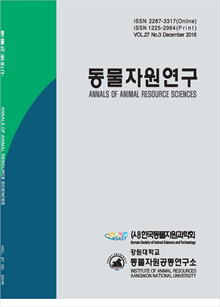간행물
동물자원연구 KCI 등재 Annals of Animal Resources Sciences

- 발행기관 강원대학교 동물자원공동연구소
- 자료유형 학술지
- 간기 계간
- ISSN 1225-2964 (Print)2287-3317 (Online)
- 수록기간 1990 ~ 2025
- 주제분류 농수해양 > 축산학 농수해양 분류의 다른 간행물
- 십진분류KDC 527DDC 636
권호리스트/논문검색
제35권 4호 (2024년 12월) 3건
1.
2024.12
구독 인증기관 무료, 개인회원 유료
This study aimed to investigate the effects of various washing pre-treatments of native Codium fragile as a feed additive on in vitro ruminal fermentation and CH4 production in ruminants. Seaweed was included at 0.5% dry matter (DM) based on the experimental feed (forage : concentrate = 3:7). Treatment groups were classified as follows: experimental feed (C), no washing (T1), washing at 0°C (T2), washing at 22°C (T3) and washing at 70°C (T4) each immersed for 6 minutes in distilled water. The pH consistently fell within the ruminal stability range. In vitro dry matter digestibility was significantly highest in T2, T3, T4 and C, T4 was the lowest at 48 h (p<0.05). NH3-N concentration was significantly highest in T4 at 48 h (p<0.05). Total gas production at 48 h was 19% lower in T4 compared to C (p<0.01). CH4 production (mL/g DM) at 48 h was lower in all treatment groups compared to C, with T3 showing a 31% reduction (p<0.01). Similarly, CH4 production (mL/g dry matter degradability, DMD) at 48 h was 39% lower for T3 compared to C (p<0.01). At 24 h, total VFA was significantly highest in T1 and T4 (p<0.05). The proportions of acetate was significantly highest in C and T3 was the lowest at 48 h (p<0.01). The proportions of propionate was significantly highest in T3 and C was the lowest at 48 h (p<0.01). The acetate to propionate ratio was singnificantly highest in C at 48 h (p<0.01). The proportions of butyrate at 24 h was lower for T3 compared to C (p<0.05). Therefore, this study confirms that Codium fragile can reduce CH4 production when used as a feed additive for ruminants and this effect is not significantly influenced by the washing pre-treatment. However, if washing process is necessary, washing at 22°C is the most appropriate method to remove foreign objects.
4,300원
2.
2024.12
구독 인증기관 무료, 개인회원 유료
The objective of the present study was to investigate the effects of different red seaweeds on in vitro rumen fermentation characteristics and methane gas production. Five species of red seaweed (Chrysymenia wrughtii Yamada, CW; Hypnea sp., Hypnea sp.; Chondria crassicaulis, CC; Gelidium vagum Okamurae, GV; Hypnea saidana Holmes, HS) were obtained from National Institute of Fisheries Science (NIFS) in South Korea. The collected red seaweeds were washed for 3 minutes, and then samples were freeze-dried and ground to a size of a 1 millimeter. The buffered ruminal fluid (50 mL) was incubated with substrates and seaweeds (5% of substrates) at 39℃ for 48 hours. Total gas production was lower than red seaweed treatments excluding the CW treatment (p<0.05; 63.25 mL). Methane production was the lowest in CC treatment (p<0.05; 9.93 mL/g of digestible dry matter). The rumen pH of the red seaweed treatments ranged from 5.98 to 6.08, which was significantly the lowest in the GV treatment (p<0.05; 5.98). There was no significant difference in the total VFA concentration, but propionate (27.53%) was significantly highest in the CW treatment, whereas acetate (53.14%), iso-valerate (3.52%), valerate (1.72%), and A:P ratio (1.93) were significantly lowest (p<0.05). In conclusion, among the five species of red seaweeds, Chondria crassicaulis reduced in vitro methane production without negative effects on dry matter digestibility. Future studies will be needed to determine the optimal inclusion level of Chondria crassicaulis as feed additive to reduce enteric methane production.
4,000원
3.
2024.12
구독 인증기관 무료, 개인회원 유료
This review examines the importance of measuring practical enteric methane emissions from ruminants, considering their significant impact on global warming. Global warming is significantly driven by an increase in greenhouse gases, with rising methane (CH4) emissions from ruminants accelerating global warming recently. To successfully mitigate CH4 emissions and establish effective strategies, it is essential to apply reliable measurement techniques. This will allow for an accurate assessment of on-farm CH4 emissions. The priority should be to gather CH4 emission data that reflects the actual state of CH4 emissions from ruminants. The review provides an overview of the methods used to measure CH4 emissions from ruminants by compiling existing researches. It introduces the concepts, principles, and limitations of these methods to facilitate comparisons between existing approaches. This review discusses methods for measuring enteric CH4 emissions from ruminants at the farm level, including the tracer technique, laser methane detector, GreenFeed, and sniffer system. These methods are highlighted as potential tools to accumulate substantial data on on-farm CH4 emission from domestic animals with provides examples of international cases. Among these, this review introduces the Sniffer method, a CH4 emission measurement techniques that are suitable for on-farm use under domestic conditions, and emphasizes the necessity of its application. In addition, by presenting international cases where predictive models were developed based on on-farm CH4 measurement techniques, it is projected that if predictive models for CH4 emissions are developed by accumulating data at the farm level, it can contribute to sustainable livestock industry in various promising ways.
5,700원

